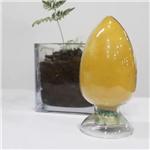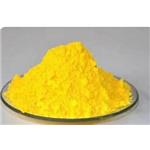Description
Acitretin is the free acid form of etretinate useful in the treatment of severe psoriasis and other disorders of keratinization. Although the two compounds have virtually the same efficacy and teratogenic side-effects, acitretin is advantageous for child-bearing women, as its shorter half-life reduces the necessary contraception period from two years to only one month after treatment ceases.
Chemical Properties
Crystalline Solid
Originator
Hoffmann-La Roche (Switzerland)
Uses
antipsoriatic;binds to nuclear receptors that regulate gene transcription
Uses
A synthetic retinoid which is the major metabolite of etretinate (E938000).
Uses
Acitretin, a retinoid that binds to nuclear receptors and regulates gene expression, is a potent activator of the α-secretase ADAM10 gene expression and apoptosis inducer via the CD95 signalling pathway. Acitretin is a systemic retinoid drug used in the treatment of severe psoriasis.
Definition
ChEBI: All-trans-acitretin is an acitretin, a retinoid and an alpha,beta-unsaturated monocarboxylic acid. It has a role as a keratolytic drug.
Indications
Unlike isotretinoin, acitretin (Soriatane) is not primarily
sebosuppressive. Rather, it promotes normalization
of dysregulated keratinocyte proliferative activity in the
epidermis and is also antiinflammatory. Oral absorption
is optimal when acitretin is taken with a fatty meal; peak
levels are reached approximately 3 hours after ingestion,
while steady-state plasma levels are achieved after
approximately 3 weeks of daily dosing. The mean terminal
elimination half-life of the parent compound is 49
hours. However, when consumed with ethanol, acitretin
may be transesterified to form etretinate, a retinoid that
is stored in adipose tissue, resulting in a much longer
half-life (3–4 months or longer).
Manufacturing Process
228 g of 5-(4-methoxy-2,3,6-trimethyl-phenyl)-3-methyl-penta-2,4-diene-1-
triphenylphosphonium bromide was added under nitrogen to 910 ml of
dimethylformamide and treated at 5-10°C within 20 min. with 17.5 g of a
suspension of sodium hydride (about 50% by weight) in mineral oil. The
mixture was stirred for 1 hour at about 10°C, then 61.8 g of 3-formylcrotonic
acid butyl ester was added dropwise at 5-8°C, a mixture was heated for 2
hours at 65°C, subsequently introduced into 8 L of ice-water, then was added
300 g of sodium chloride, and the mixture thoroughly extracted with a total
18 L of hexane. The extract was washed 5 times with 1 L of methanol/water
(6:4 parts by volume) each time and 2 times with 1.5 L water each time,
dried over sodium sulphate and evaporated under reduced pressure to leave
9-(4-methoxy-2,3,6-trimethylphenyl)-3,7-dimethyl-nona-2,4,6,8-tetraen-1-oic
acid butyl ester, m.p. 80-81°C.
125.8 g of this ester was introduced into 2 L of abs. ethanol and treated with
a solution of 125.6 g of hydroxide in 195 ml of water. The mixture was heated to boiling under nitrogen gassing for 30 minutes, then cooled, introduced into
10 L of ice-water and, after the addition of about 240 ml of conc. hydrochloric
acid (pH 2-4), thoroughly extracted with total 9 L methylene chloride. Extract
is washed with about 6 L water to neutrality, dried over calcium chloride and
evaporated under reduced pressure. The residue is taken up in 700 ml of
hexane. The precipitated 9-(4-methoxy-2,3,6-trimethyl-phenyl)-3,7-dimethylnona-
2,4,6,8-tetraen-1-oic acid melts at 228-230°C.
brand name
Soriatane (Connetics);Neotigason (r) 10;Neotigason roche 10 mg;Neotigason sauter kapsein 25 mg.
Therapeutic Function
Antipsoriatic
World Health Organization (WHO)
Acitretin, a retinol derivative, was introduced in 1989 for the
treatment of severe psoriasis. By the end of 1990, acitretin was confirmed to be
metabolized in part to etretinate. Marketing authorization was suspended
temporarily in France while the product information was modified to conform to the
recommendations issued by the Committee for Proprietary Medicinal Products of
the European Communities. Acitretin remains registered in several countries. See
also WHO comment for etretinate.
General Description
Pharmaceutical secondary standards for application in quality control, provide pharma laboratories and manufacturers with a convenient and cost-effective alternative to the preparation of in-house working standards.
Acitretin is a major metabolite of etretinate and belongs to the class of retinoid and is typically used for treating psoriasis. Acitretin inhibits excessive cell growth and keratinisation which are the major symptoms of psoriasis, therefore reducing plaque formation and scaling.
Biochem/physiol Actions
Synthetic retinoid that is a metabolite of etretinate. Preferentially binds to cellular retinoic acid binding proteins (CRABPs).
Mechanism of action
Acitretin
(Soriatane) is a synthetic derivative of vitamin A that is particularly effective in
treating the pustular and erythrodermic forms of psoriasis. It is the main metabolite
of etretinate; ingestion of alcohol with acitretin increases the amount of detectable
etretinate. It is accumulated in fatty tissue with a prolonged elimination half-life of
approximately 120 days. Most patients show improvement within 2 to 4 weeks,
although some patients may need as long as 6 months of therapy before a response
is noted.
Pharmacology
Like other systemic retinoids, acitretin is a serious
teratogen and should not be prescribed for women of
childbearing potential unless no acceptable alternative
is available and the patient has acknowledged in writing
that she understands the need to use two effective
forms of contraception during therapy and for 3 years
following discontinuation of therapy. Because of the
much longer half-life of etretinate, which may be
formed when ethanol is ingested with acitretin, female
patients of childbearing potential must also agree not to
ingest alcohol during treatment and for 2 months following
its discontinuation. Other toxicities are similar
to those of isotretinoin; they include cutaneous irritation
and inflammation, bone and joint pain, hyperlipidemia,
hepatic enzyme elevation, and tendinous and
ligamentous calcifications.Alopecia (hair loss) may also
occur in some patients.
Clinical Use
Acitretin is most useful for the treatment of severe
psoriasis, particularly the pustular and erythrodermic
variants. Psoriatic nail changes and arthritis also may respond.
Combining the drug with ultraviolet light therapy
(Re-UVB, in the case of ultraviolet B radiation, or
Re-PUVA, with psoralen plus ultraviolet A radiation)
permits the use of lower doses of both acitretin and ultraviolet
radiation. Other conditions for which the drug
may be especially useful include congenital and acquired
hyperkeratotic disorders, such as the ichthyoses
and palmoplantar keratodermas, and severe lichen
planus.
Side effects
Side effects are dose dependent and include elevation of triglycerides,
hepatitis, hair loss, thinning of the nails, cheilitis, xerosis, and stickiness of
the skin. Gemfibrozil (300 mg b.i.d.) corrects elevated lipid levels on this
therapy.
Veterinary Drugs and Treatments
Acitretin may be useful in the treatment of canine lamellar ichthyosis,
solar-induced
precancerous lesions in Dalmatians or bull
Terriers, actinic keratoses, squamous cell carcinomas,
and intracutaneous
cornifying epitheliomas (multiple keratoacanthomas).
While the drug has provided effective treatment of idiopathic
seborrhea (particularly in cocker spaniels), it is not effective in treating
the ceruminous otitis that may also be present. Results have
been disappointing
in treating idiopathic seborrheas seen in basset
hounds and West Highland terriers.
Acitretin’s usage in cats is very limited, but etretinate has shown
some usefulness in treating paraneoplastic
actinic keratosis, solarinduced
squamous cell carcinoma and Bowen’s Disease in this
species.
Drug interactions
Potentially hazardous interactions with other drugs
Alcohol: increased risk of teratogenicity in women.
Antibacterials: possibly increased risk of benign
intracranial hypertension with tetracyclines - avoid
concomitant use.
Anticoagulants: possible antagonism of the
anticoagulant effect of coumarins.
Cytotoxics: increased concentration of methotrexate
(also increased risk of hepatotoxicity) - avoid
concomitant use.
Vitamin A: risk of hypervitaminosis - avoid
concomitant use.
Metabolism
Acitretin is metabolised by isomerisation into its 13-cis
isomer (cis acitretin), which is also a teratogen, by
glucuronidation and cleavage of the side chain. Acitretin
is excreted entirely in the form of its metabolites, in
approximately equal parts via the kidneys and the bile.






